Everything You Need To Know About Cooking With Heirloom Tomatoes
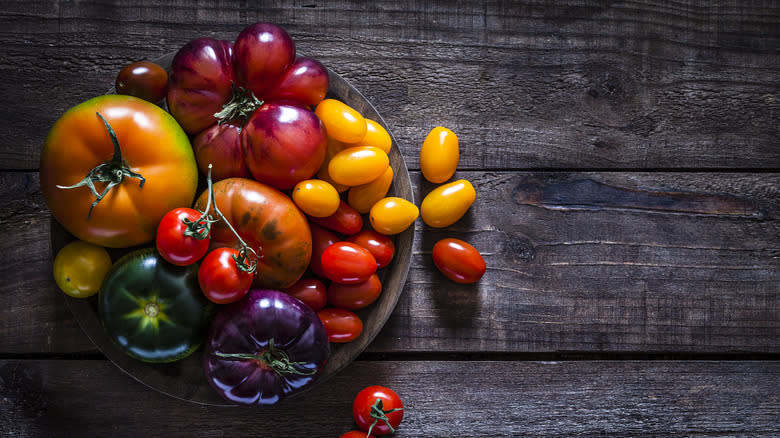
If you've ever strolled through the stalls of a farmer's market in the summer or perused the produce section of a specialty grocery store, you've probably seen chunky, misshapen tomatoes sporting marbled color patterns and steep price tags. These eye-catching vegetables (or fruits if you want to get technical) are one of the most prized seasonal crops. Known as "heirloom tomatoes," they are open-pollinated, meaning that they are pollinated by natural facilitators like wind, bees, and birds. Heirloom is a botanical classification describing crops that are passed down as seeds from generation to generation of growers. There is no unifying flavor or color, but each variety is a time capsule that can be traced back in its current form for decades, sometimes even centuries. In contrast, most of the tomatoes you find in the store are known as "hybrids" because they possess the genetics of multiple varieties of tomatoes that have been cross-bred for qualities like color consistency, durability, high yield, and disease resistance.
Just as their appearances and flavors differ from conventional tomatoes, heirloom tomatoes have unique variations in texture and moisture content that can make them intimidating for even experienced cooks. You could swap them for regular tomatoes in your favorite recipes, but you'll likely end up with undesirable results or, at the very least, results that do not do them justice. With this in mind, we've rounded up all the information you need to get the most out of these endearingly misshapen, strikingly colored fruits.
Read more: Mistakes You're Making With Your Corn On The Cob
They're More Expensive Than Other Types Of Tomatoes
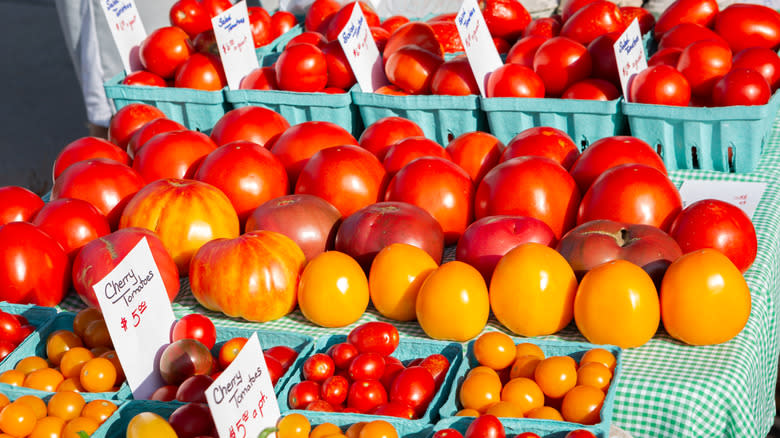
One of the greatest consistencies between varieties of heirloom tomatoes is their price tags. Simply put, they are much more expensive than hybrid tomatoes. The retail price for field-grown tomatoes in the U.S. has not exceeded $2.47 per pound on average per year since 2000 (per Statista), but heirloom tomatoes typically cost between $4 and $6 per pound. You might even find some that cost as much as $10 per fruit. The inevitable questions are, "Why?" and "Are they worth it?" While the answer to the latter is up for debate, the answer to the former is more clear-cut.
Because heirloom tomatoes are selected for their flavor and have not been modified over the years to cater to commercial production concerns, each plant yields less fruit than hybrid tomato plants and growers are forced to ask for a higher price to make a profit. They have also not been bred to be durable or pest-resistant, and they are more vulnerable to diseases and bugs and harder to transport long distances.
There Are Many Varieties
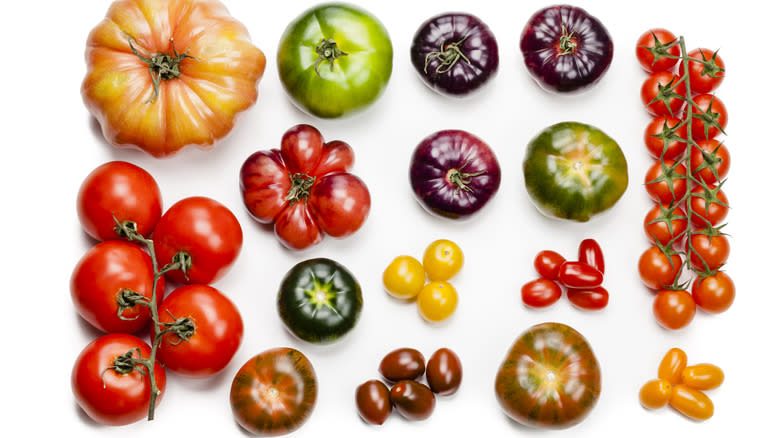
"Heirloom tomato" is a generic term used to describe a wide range of varieties. All told, there are about 3,000 of them, though this is only an estimate given that the definition of the term is disputed. To be an heirloom, the seeds must be passed down, creating plants that are identical to the original. How long the seeds must be passed down is where the controversy lies. Some say the lineage must go back only 50 years, while others argue that it must be traceable by at least 100 years (per the University of California).
Of the varieties that are widely accepted as part of the category, however, some stand out as the most popular. There's the Black Krim, which is a deep shade of purple and has a meaty texture, and the Beam's Yellow Pear which is a bright golden color, cherry-sized, and pear-shaped. The Green Zebra is known for its striking marbled green appearance even when ripe, while the Mr. Stripey is a reddish-orange version of the same pattern. Then there are the varieties that are worth buying for their names alone. There's the Mortgage Lifter, for example, the Hillbilly, and the Cosmonaut Volkov. Each variety has its own flavor and appearance, even though they might simply be called "heirlooms" on the label.
The Color Doesn't Always Indicate The Flavor
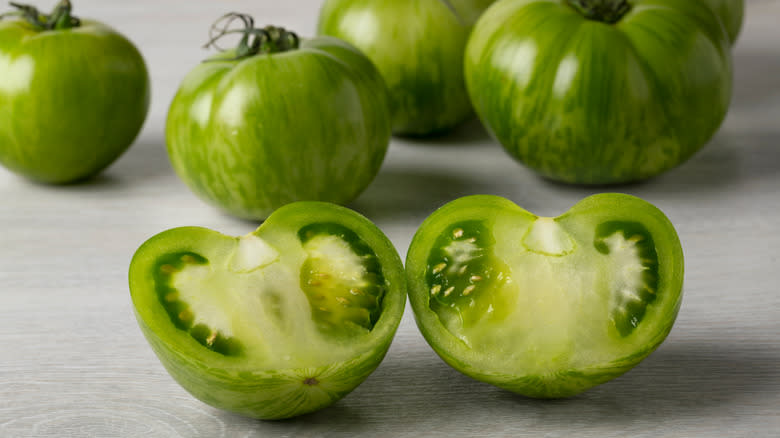
The first thing most people notice about heirloom tomatoes is their color. Red, green, white, orange, yellow, dark purple, speckled, marbled, and striped, they present a dizzying array. But while their colors are attention-grabbing, they can also lead you astray. You might assume, for example, that a Green Zebra tomato would taste sour or grassy, like an unripe red tomato, but it tastes very similar to a juicy, lusciously ripe oxheart tomato, with just the faintest tang. Similarly, the deep yellow Hawaiian Pineapple does not taste like its tropical namesake. Instead, it has a mildly sweet flavor with a subtle citrusy aftertaste. On the other side of the color spectrum, the Black Krim has the same royal purple hue as an eggplant but is known for its rich, sweet, even slightly salty flavor.
No matter which heirloom tomato you opt for, it's worth noting that all varieties taste like tomatoes. Despite their names and color differences and the taste profiles you'll find in gardening manuals, they are not wildly distinct unless you happen to be a tomato connoisseur. The greatest indication of whether you'll enjoy the flavor is how carefully and expertly they were grown.
They Have A Short Shelf Life
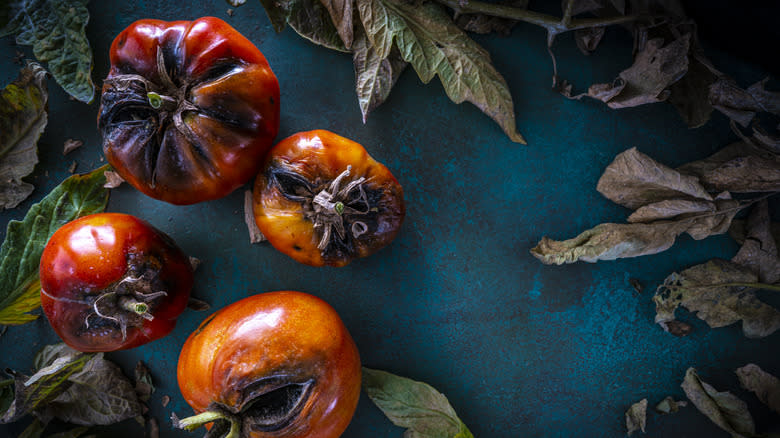
One of the most important factors to keep in mind when purchasing heirloom tomatoes is that they spoil quickly. Because they are not bred to be durable the way hybrid tomatoes are, their shelf life is much shorter, so you'll need to readjust your expectations and cooking schedule when you buy them. These are not the kind of ingredients you can purchase a few days before making a recipe. You'll need to get them no more than one or two days before you plan to use them, depending on how ripe they are when you buy them.
To maintain their delicate texture, it's best not to store heirloom tomatoes in the refrigerator (at least until they've been cut). Instead, keep them on your counter out of direct sunlight and under a mesh sieve or breathable cloth. To prevent them from losing juiciness, position them stem side down. This step might seem arbitrary, but the area around the stem is the only part of the tomato that isn't covered in shiny, watertight skin. Because of this, moisture can leech out, and flipping it upside down to seal it against the counter will prevent your juicy heirlooms from shriveling.
They Provide Vivid Flavor
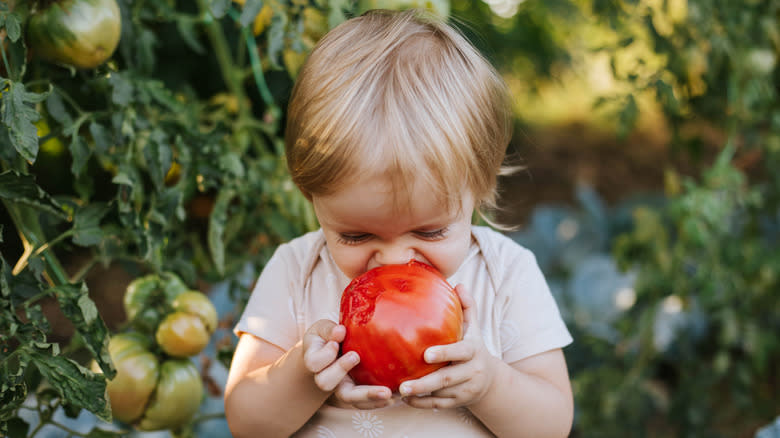
People are willing to pay a premium for heirloom tomatoes because, for the most part, they contain much more flavor than hybrid varieties. If you've ever purchased a vivid red Roma tomato only to discover once you bite into it that it's mealy and tasteless, you're not alone. Hybrid tomatoes are not bred for their flavor, and while many provide acidity and sweetness, most producers simply aren't as concerned about this element as they are about making sure their products get to grocery stores around the country without splitting or rotting. These tomatoes are often picked when they're still green and sprayed with ethylene gas, accelerating their ripening process so that they're ready to be sliced open the moment they hit the produce aisle. But this tampers with the natural ripening process and robs them of flavor.
The flavor disparity has an even more clear-cut cause than premature ripening. According to research from Stanford University, many hybrid tomatoes contain a genetic mutation that was bred into them in the mid-20th century to facilitate uniformly red ripening. The gene helps farmers quickly spot ripe tomatoes on the vine and predict how long it would take them to reach full ripeness once harvested, but it also has the unfortunate side effect of removing the gene that facilitates the full development of sugars. As a result, many hybrid tomatoes couldn't even reach full, sugary ripeness no matter how carefully they were cultivated.
They Can Be Difficult To Find
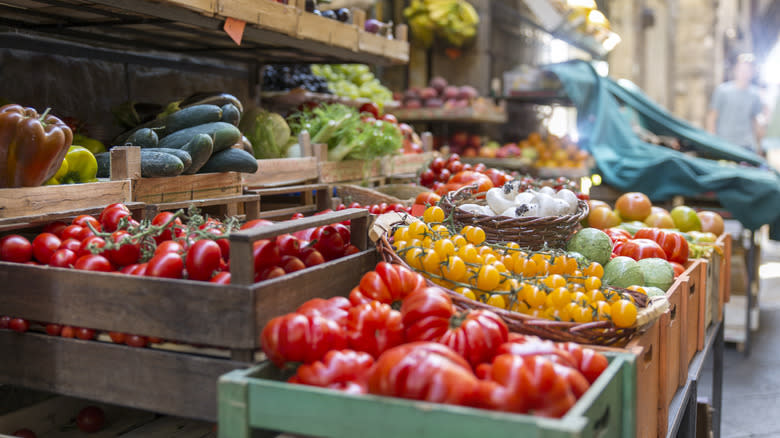
Unlike hybrid tomatoes, which you can find in just about any grocery store year-round, heirloom tomatoes can be difficult to track down. If you live somewhere with a farmer's market, you're almost certain to find heirlooms at some point during the summer, while nationwide, grocery store chains like Whole Foods, Trader Joe's, and Sprouts often carry them, though this may vary by location.
The main factor determining when you'll find heirlooms is seasonality. Summer is tomato season, and while commercial hybrid tomatoes can be harvested when they're green and delivered to grocery stores year-round, most heirlooms are limited to the period between late summer and early fall. If you do happen upon some that are available outside this period, don't get too excited. Just like hybrid tomatoes, heirloom tomatoes can be strategically harvested to sell at any point during the year, but the quality will not be nearly as desirable as the ones that are harvested in the summer when their sugars have had time to develop naturally.
You'll Want To Make Them The Star Of The Show
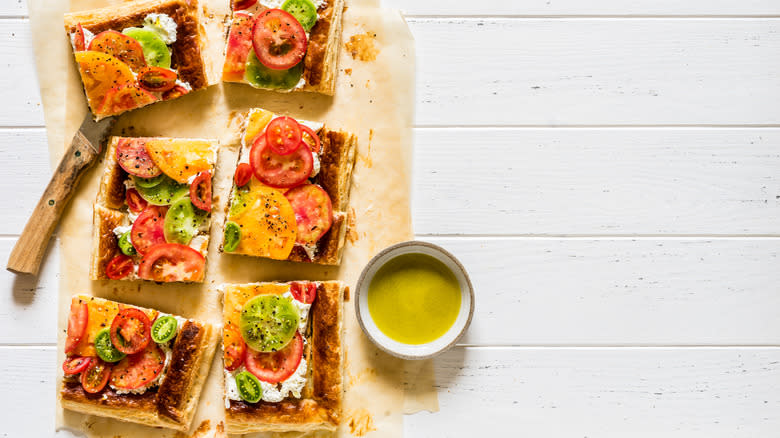
Once you have your pricey heirloom tomatoes, you'll want to make sure you use them wisely. First and foremost: use them quickly. Second: keep things simple. As soon as you take your first bite of a Costoluto Genovese, Brandywine Pink, or Cherokee Green, you realize that you need not have worried about how to cook with them, because the best way to use them is to make them the main ingredient. Aside from serving a plate of freshly sliced heirlooms with nothing but a little salt and pepper (this happens to be one of the best options), you can bake them into a galette with a dusting of Parmesan, pile them fresh onto a cooked pizza, roast them in slices, or bake them in a tart shell with cream cheese and herbs.
One of the best ways to let heirlooms shine is to turn them into gazpacho. This cold soup was created in the hot climate of Southern Spain and is made with blended raw vegetables. Tomatoes, bell peppers, and onions are traditional, but you can throw in any fresh produce you favor. Heirloom tomatoes lend more flavor than standard store-bought tomatoes and add an even more refreshing, summery element to the famously summery dish.
They Are Usually Served Fresh
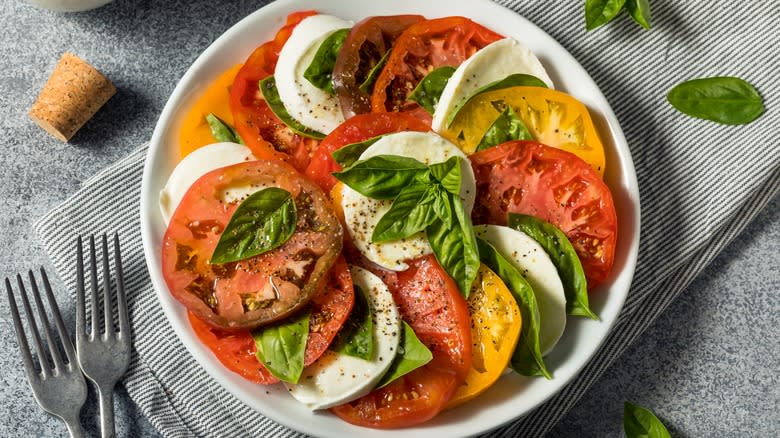
There are innumerable ways to cook with heirloom tomatoes, but many recipes call for keeping them fresh. Their subtle flavor differences, vibrant colors, and tender, juicy structures are put on full display when they are left uncooked, which is preferable considering how easily they fall apart when subjected to heat. Salad is the obvious choice for appreciating these unique tomatoes to the fullest. A simple combination of colorful heirlooms, fresh herbs, and a little olive oil and balsamic vinegar will give you summertime on a plate. Adding circles of mozzarella to create an elevated version of Caprese salad will make them even more mouthwatering. If you served it at a Michelin-starred restaurant, no one would question whether it belonged alongside gold-encrusted caviar and wine with triple-digit prices.
Another option that is perfect if you only have half a tomato left is to use it as a garnish. You might not think that a tomato could have enough flavor for the task, but an heirloom at peak freshness is full of sweetness, acidity, and all the nuances associated with its specific variety. Grilled meat, rice stir-fries, green salads, and creamy soups all taste and look better with small juicy morsels of brightly colored tomato. It might not be as conventional as a smattering of fresh herbs, but heirloom slices will be just as delicious and even more eye-catching.
Take Care When Choosing Them
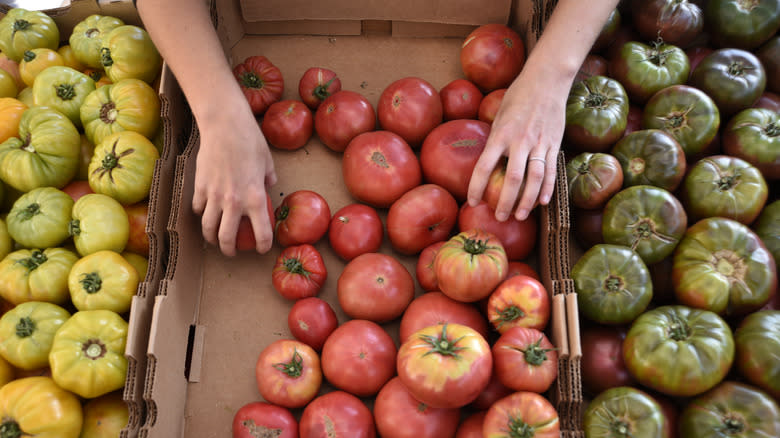
There are various ways to tell whether types of fruit are high-quality. Watermelons should be heavy and firm, grapes should be plump, and strawberries should be an even color. Picking high-quality hybrid tomatoes is just as straightforward. They should be bright, uniformly red, plump, and have no scarring or bruising. But heirloom tomatoes are trickier. Because they haven't been bred for a flawless appearance, many of the highest-quality specimens have mottled skin, bumps, and scarring. Don't be afraid of these blemishes. In most cases, they indicate that the variety has been bred for its delicious flavor, which is exactly what most of us are looking for.
Since you can't gauge quality by appearance, you might be tempted to go by touch, but although we're free to pick up and squeeze the produce at most grocery stores, more restraint is expected with heirlooms. With thinner skin and a high proportion of moisture, they are quick to split and spoil. Do not, whatever you do, pick up an heirloom tomato and squeeze it. No matter how gentle you are, you will bruise its fragile flesh and kickstart the rotting process. Farmers throw out dozens of pounds of would-be-perfect tomatoes every day due to tactile customers who don't realize the damage they're causing. The best course of action is to ask the seller to pick for you, or, if the seller isn't present, gently pick up the fruit and sniff it without applying pressure with your fingers.
Different Varieties Serve Different Cooking Purposes
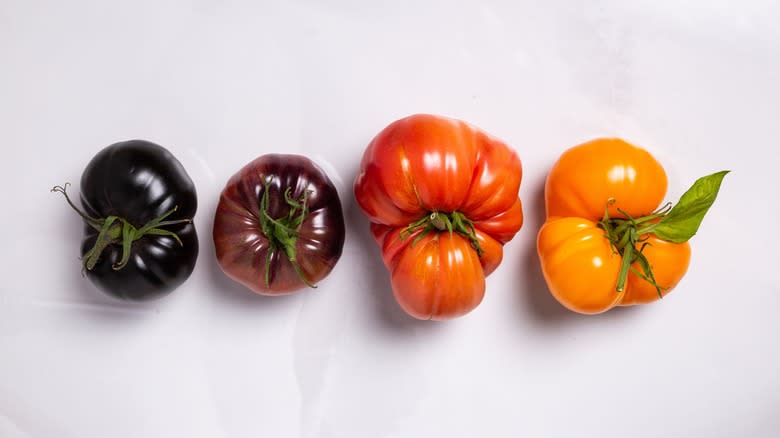
If you purchase heirloom tomatoes from a local grower in peak season and toss them with olive oil and salt, you're probably going to be pretty pleased with the results. But if you want to take things to the next level, you can purchase specific heirloom varieties for the type of recipe you're making. Depending on what is available, you can choose tomatoes that are tart and acidic, sweet and fruity, or rich and earthy.
For example, the Cherokee Purple is sweeter than it is acidic, with a deep, complex flavor that is best left as unadulterated with other ingredients as possible. Add it to a sandwich or salad for a refreshing juicy sweetness. If you want a tomato that looks as uniform, blemish-free, and symmetrical as a hybrid but packs a flavorful punch, the Druzba is ideal. The seeds produce round, juicy fruits that are smooth, deep red, and bursting with a powerful balance of sugar and tartness. They are an excellent choice if you want a classic tomato appearance that tastes better than the standard store-bought varieties. For an impressive flavor and visual flair, look for Black Cherry tomatoes. Small and round like sparkly, speckled cherries, they have a sweet, rich flavor and are a striking addition to salads.
They Have Thin Skins
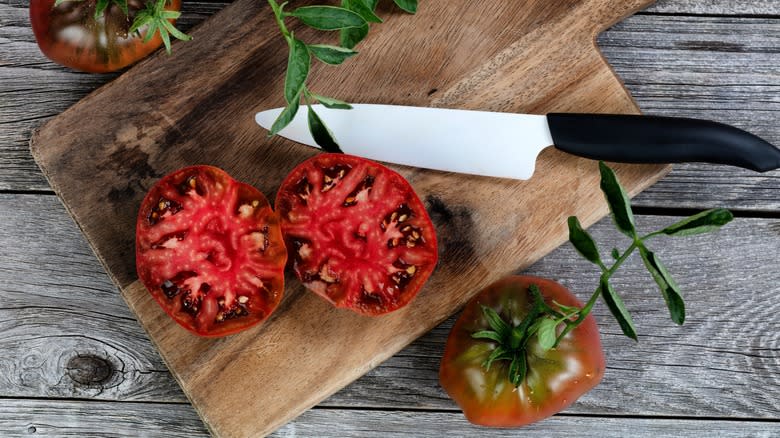
One of the biggest selling points of heirloom tomatoes is also the reason they are not sold more widely. Their skins are much thinner than hybrid tomato skins, giving them a buttery and juicy texture, but also making them prone to bruising, splitting, and rotting. As such, they are a headache to transport, which is why they're often produced by local growers.
Thin skins also mean that they cook differently than the more robust varieties of hybrids. Rather than holding their shape in soups and stews, they fall apart almost immediately, becoming part of the broth rather than a discernable vegetable. Many recipes leave them uncooked for this reason. If you do plan to cook with them, however, it's best to pureé or roast them. Puréed heirlooms lend plenty of liquid and bright flavor to soups and salsas, whether you cook them first or blend them fresh. Roasting them might seem counterintuitive since the high heat of an oven is destructive to even the most robust butternut squash let alone a delicate Green Zebra, but the key is to roast slowly and avoid stirring or turning. Letting sliced tomatoes roast in heat no higher than 250 degrees Fahrenheit for up to two hours will yield results that are still juicy and vibrantly colored but have a more concentrated flavor.
Their Quality Can Be Inconsistent
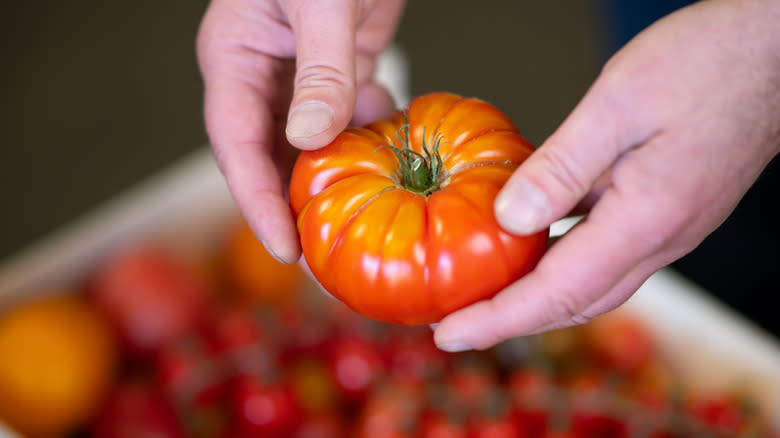
Heirloom tomatoes are touted for their flavor, and while it is true that they are largely bred to be delicious rather than robust and flawlessly shaped, they are not guaranteed to be tasty. They aren't even guaranteed to taste better than hybrid tomatoes. Given their rise in popularity, heirlooms are now grown year-round and on a large scale to accommodate nationwide grocery stores like Trader Joe's and Whole Foods. As a consequence, some of them receive the same treatment as generic tomatoes, including premature harvesting and rapid, artificial ripening. If you're faced with the option of locally grown cherry tomatoes in the summer or heirloom tomatoes that have been shipped from thousands of miles away in the dead of winter, you're likely to be thrilled by the results of the former and disappointed by the results of the latter.
When it comes down to it, natural ripening in good soil will produce better-tasting tomatoes, and that might mean opting for a familiar hybrid rather than a pricey, exotic-looking heirloom. That said, if you're at the farmer's market in late August and you can choose between a Roma tomato grown down the road and a Black Krim grown on the same farm, the Black Krim will beat it for flavor (and drama) every time.
Read the original article on Mashed

